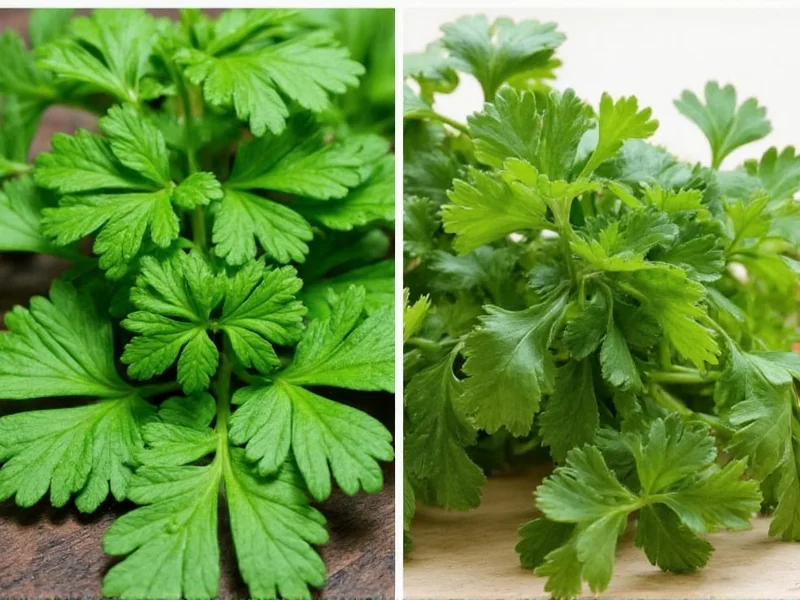Understanding the Visual Differences Between Parsley and Cilantro
When standing in the grocery store unsure which herb you're holding, leaf shape provides the most reliable identification clue. Curly parsley forms tight, ruffled balls of dark green foliage, while flat-leaf (Italian) parsley—the variety most confused with cilantro—has broad, pointed leaves with distinct serrated edges resembling flat-leaf lettuce. Cilantro, by contrast, produces soft, rounded leaves with gently curved edges that appear almost lacy. The stems tell another story: parsley stems are thick and sturdy, often fibrous, while cilantro stems are thinner and more delicate.
| Feature | Parsley | Cilantro |
|---|---|---|
| Leaf Shape | Pointed, serrated edges (flat-leaf) or curly ruffles | Rounded, lacy appearance with smooth edges |
| Color | Bright to dark green | Lighter, more yellow-green |
| Stem Texture | Thick, fibrous, often tough | Thin, delicate, more tender |
| Flavor Profile | Mild, grassy, slightly bitter | Strong citrus notes, sometimes soapy (to some) |
| Common Culinary Uses | Garnish, Mediterranean dishes, tabbouleh | Mexican, Asian, and Indian cuisines, salsas |
Flavor Profiles: Why Substitution Changes Your Dish
The taste difference between parsley vs cilantro fundamentally alters recipes. Flat-leaf parsley delivers a clean, mild bitterness that complements rather than dominates—think of it as the supporting actor in Mediterranean dishes. Cilantro, however, plays a lead role with its vibrant citrus notes and distinctive aroma. Approximately 21% of people possess a genetic variation that makes cilantro taste like soap, explaining why some strongly dislike it while others crave its unique flavor.
When considering whether you can substitute parsley for cilantro in guacamole or salsa, the answer is generally no. Cilantro's citrusy punch is essential to authentic Mexican and Southeast Asian dishes. Replacing it with parsley creates a completely different flavor profile that misses the intended culinary experience. However, in dishes where herbs play a supporting role—like potato salad or roasted vegetables—substitution might work with adjusted expectations.
Culinary Applications and Regional Preferences
Chefs worldwide leverage these herbs differently based on regional traditions. In Middle Eastern cuisine, flat-leaf parsley stars in tabbouleh, comprising up to 80% of the dish. Mediterranean cooking uses parsley as a finishing herb for grilled meats and fish. Cilantro, meanwhile, is indispensable in Mexican salsas, Thai curries, and Indian chutneys where its bright flavor cuts through rich spices.
Understanding parsley vs cilantro taste difference prevents culinary disasters. Adding cilantro to a traditional Italian pesto (which uses parsley or basil) creates an unexpected flavor clash, while using parsley in Vietnamese pho would miss the aromatic complexity cilantro provides. Professional cooks emphasize matching the herb to the cuisine's flavor profile rather than treating them as interchangeable green garnishes.
Nutritional Comparison: Health Benefits Side by Side
Both herbs offer impressive nutritional profiles, but with different strengths. Parsley contains exceptionally high levels of vitamin K (1,640% of daily value per 100g), crucial for blood clotting and bone health. It also provides significant vitamin C and folate. Cilantro delivers more vitamin A and potassium, with notable antioxidant properties. Both contain compounds that may support detoxification pathways, though research continues on their specific health impacts.
When analyzing nutritional comparison of parsley and cilantro, remember that typical serving sizes are small (2-3 tablespoons chopped), so while both are nutrient-dense, they contribute modest amounts to daily requirements. Neither herb contains significant calories, making them excellent flavor boosters for calorie-conscious cooking.
Growing Conditions for Home Gardeners
Gardeners seeking to grow parsley vs growing cilantro should note their different requirements. Parsley thrives in cooler temperatures (50-75°F), tolerates partial shade, and has a longer germination period (up to 4 weeks). It's a biennial plant that often returns for a second growing season. Cilantro prefers full sun, grows quickly (germinates in 7-10 days), but bolts (goes to seed) rapidly in warm weather, making it challenging to maintain through summer.
Successful cilantro cultivation often involves successive plantings every 2-3 weeks during cooler months. Some gardeners prefer growing cilantro in partial shade to extend its harvest window. Parsley, being more cold-hardy, often survives light frosts that would kill cilantro. Both herbs grow well in containers, making them suitable for balcony or windowsill gardening.
Why the Confusion Persists and How to Avoid Mistakes
The persistent mix-up between identifying fresh parsley and cilantro stems from several factors. Grocery stores often display them side by side with similar packaging. Their botanical relationship (both in the Apiaceae family) means they share some visual characteristics, especially when young. Cultural differences compound the issue—in many Latin American countries, cilantro is called "culantro," while true culantro (Eryngium foetidum) is a different plant altogether.
To avoid culinary mishaps when distinguishing parsley from cilantro, use this three-point check: 1) Examine leaf edges (serrated = parsley, rounded = cilantro), 2) Smell the herb (citrusy = cilantro, grassy = parsley), 3) Check stem thickness (thick = parsley, thin = cilantro). When in doubt, taste a tiny leaf—but be cautious if you're among those who perceive cilantro as soapy.











 浙公网安备
33010002000092号
浙公网安备
33010002000092号 浙B2-20120091-4
浙B2-20120091-4